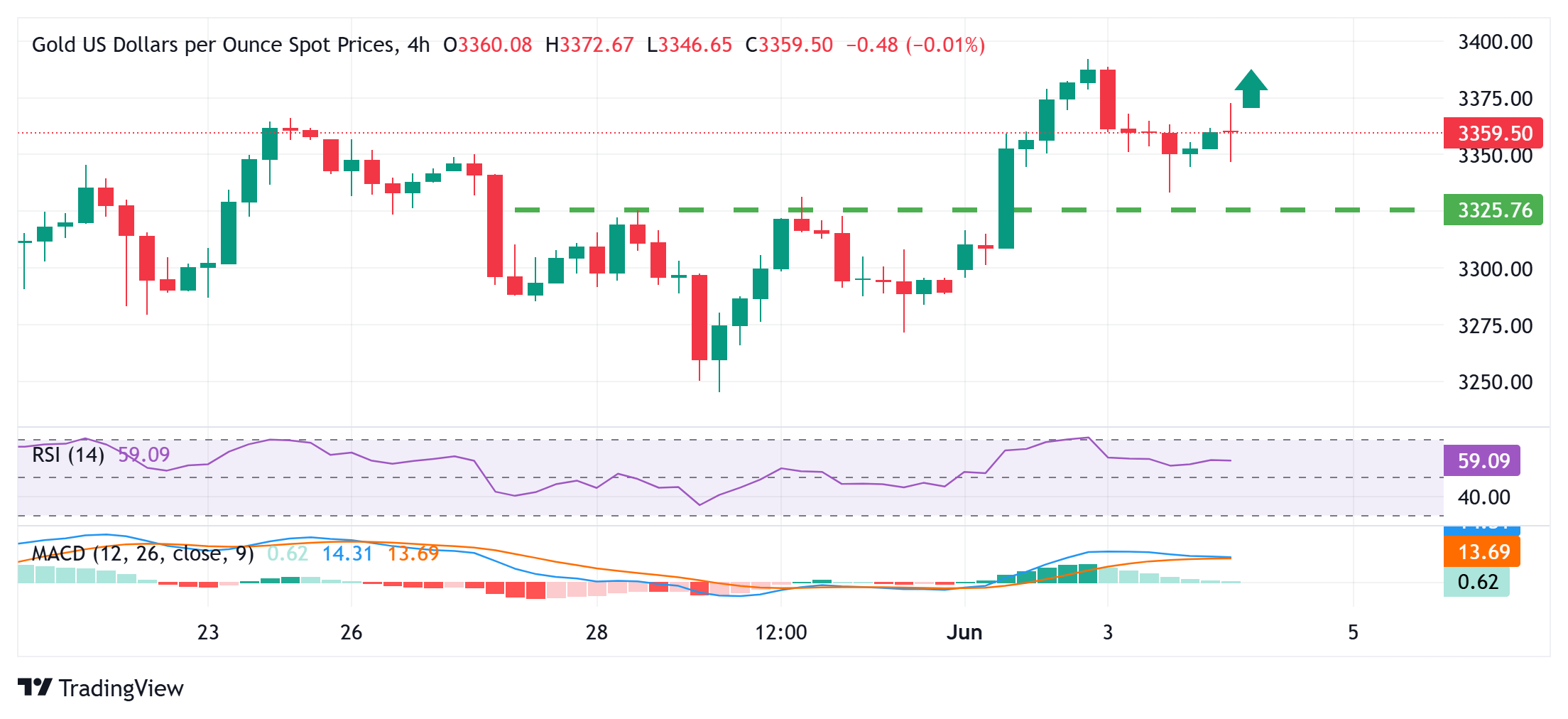- Gold price struggles to preserve modest Asian session gains, though the downside seems limited.
- Fed rate cut bets and US fiscal concerns should cap the USD recovery and support the commodity.
- Geopolitical risks and persistent trade-related uncertainties could further underpin the XAU/USD.
Gold price (XAU/USD) attracts some intraday sellers following an Asian session uptick to the $3,372-3,373 area, though it lacks follow-through and holds above the overnight swing low. The US Dollar (USD) looks to build on the previous day’s bounce from a six-week low, which, along with a generally positive risk tone, exerts some downward pressure on the commodity. However, a combination of factors warrants some caution before positioning for an extension of the overnight pullback from a nearly four-week high.
Investors seem convinced that the Federal Reserve (Fed) will lower borrowing costs further by the end of this year amid signs of easing inflationary pressures in the US. Adding to this, concerns about the worsening US fiscal conditions might hold back the USD bulls from placing aggressive bets and offer some support to the Gold price. Furthermore, persistent geopolitical risks and trade-related uncertainties should limit deeper losses for the safe-haven precious metal. Traders now look to the US macro data for a fresh impetus.
Daily Digest Market Movers: Gold price bulls seem reluctant amid a modest USD uptick
- The Job Openings and Labor Turnover Survey (JOLTS) released on Tuesday showed that there were 7.39 million job openings on the last business day of April. The reading exceeded expectations of 7.1 million and also surpassed the 7.2 million openings recorded in March. The data pointed to the continued resilience of the US labor market and bolsters optimism regarding the health of the economy.
- Despite the upbeat data, the US Dollar faced some pressure from declining US Treasury bond yields and bets that the Federal Reserve (Fed) will deliver at least two 25 basis points rate cuts by the end of this year. Moreover, concerns that the US budget deficit could worsen at a faster pace than expected on the back of US President Donald Trump’s flagship tax and spending bill weigh on the Greenback.
- Atlanta Fed President Raphael Bostic said on Tuesday that he is ‘very cautious’ about jumping to cutting rates and that the best monetary policy approach now entails ‘patience’. Bostic added that there is still a way to go on inflation as core prices are still an issue and that recession is not in his forecast right now, though he sees a possible path to one interest rate cut this year, depending on the economy.
- Meanwhile, Chicago Fed President Austan Goolsbee noted that a slowdown related to tariffs might not show up for a while in the data. All indicators point to stable and full employment and we have to wait and see if tariffs have a big or small inflation impact, Goolsbee added further.
- Separately, Fed Board of Governors member Lisa Cook said that the trade policy is now affecting the economy and may make it harder to get inflation lower. Cook expects increased inflation and reduced activity because of tariffs and warned that tariffs could lead to a stagflation environment. The Fed’s monetary policy is well-positioned for a range of scenarios, Cook added further.
- Trump and Chinese President Xi Jinping are expected to hold a call this week, likely on Friday, amid renewed fears of a trade war between the world’s two largest economies. Furthermore, the increase in steel and aluminum import tariffs from 25% to 50% come into effect on Wednesday. This keeps the trade-related risk premium in play and offers some support to the safe-haven Gold price.
- Traders now look forward to the release of the US ADP report on private-sector employment and the US ISM Services PMI. Apart from this, speeches from influential FOMC members will drive the USD demand and provide some meaningful impetus to the XAU/USD pair. The focus, however, remains glued to the official monthly jobs data, popularly known as the Nonfarm Payrolls (NFP) report.
Gold price dips towards $3,326-3,324 hurdle-turned-support could be seen as buying opportunity

From a technical perspective, the emergence of dip-buying on Wednesday comes on top of this week’s breakout through the $3,324-3,326 barrier. Moreover, oscillators on daily/hourly charts are holding comfortably in positive territory and suggest that the path of least resistance for the Gold price is to the upside. However, any subsequent move up could face some resistance near the $3,380 region ahead of the $3,400 neighborhood or a multi-week high touched on Tuesday. A sustained strength beyond the latter should allow the XAU/USD pair to retest the all-time peak touched in April and make a fresh attempt to conquer the $3,500 psychological mark.
On the flip side, weakness below the $3,355 area might continue to attract some dip-buyers and is more likely to remain limited near the aforementioned resistance breakpoint, around the $3,326-3,324 area. Some follow-through selling, however, could make the commodity vulnerable to weakening further below the $3,300 mark and testing the $3,286-3,285 horizontal support.
US Dollar PRICE Today
The table below shows the percentage change of US Dollar (USD) against listed major currencies today. US Dollar was the strongest against the Japanese Yen.
| USD | EUR | GBP | JPY | CAD | AUD | NZD | CHF | |
|---|---|---|---|---|---|---|---|---|
| USD | 0.03% | 0.05% | 0.25% | 0.02% | 0.12% | 0.02% | 0.05% | |
| EUR | -0.03% | -0.01% | 0.20% | -0.02% | 0.08% | -0.03% | 0.00% | |
| GBP | -0.05% | 0.00% | 0.16% | -0.03% | 0.09% | -0.02% | 0.02% | |
| JPY | -0.25% | -0.20% | -0.16% | -0.20% | -0.17% | -0.16% | -0.15% | |
| CAD | -0.02% | 0.02% | 0.03% | 0.20% | 0.10% | -0.00% | 0.03% | |
| AUD | -0.12% | -0.08% | -0.09% | 0.17% | -0.10% | -0.11% | -0.07% | |
| NZD | -0.02% | 0.03% | 0.02% | 0.16% | 0.00% | 0.11% | 0.03% | |
| CHF | -0.05% | -0.01% | -0.02% | 0.15% | -0.03% | 0.07% | -0.03% |
The heat map shows percentage changes of major currencies against each other. The base currency is picked from the left column, while the quote currency is picked from the top row. For example, if you pick the US Dollar from the left column and move along the horizontal line to the Japanese Yen, the percentage change displayed in the box will represent USD (base)/JPY (quote).

